Why Is Camera Upload to Pc So Slow?
Finding the Universe contains affiliate links, meaning if you lot make a buy through these links, we may earn a commission at no extra cost to you.
Once you've done a bit of research into photography, y'all might first to come up across photographers and photography websites recommending that y'all shoot in "RAW". But what is RAW in photography, and why do and then many photographers recommend it?
Well, in this post, I'm going to tell you everything you demand to know about RAW. What it is, why yous should shoot in RAW – and even some reasons why you might non want to shoot in RAW.
This post is written based on my years as a professional photographer, and too teaching people photography, both online, and at workshops effectually the earth, where often 1 of my main goals is to educate everyone on the benefits of shooting in RAW.
Permit'southward go started.
Tabular array of Contents
What is RAW in Photography?
A RAW file is simply a digital image file that is stored on your photographic camera or smartphones memory card. It is minimally processed and is ordinarily uncompressed.
Every camera manufacturer has their own RAW file format, for case Catechism RAW files are .CR2 or .CR3, whilst Nikon are .NEF.
When it comes to smartphones, most Android smartphones which support RAW primarily shoot in DNG, which is a universal RAW file format. Apple has a new ProRAW format.
Let's expand on this a fleck for clarity.
When using a photographic camera, the two main photo formats available are JPG (or JPEG) and RAW.
Normally when yous shoot with a digital camera or smartphone, the default setting is for it to save the images you have to your camera's retentivity card in a compressed format. The standard on most cameras and devices is a format known as JPEG. JPEG simply stands for "Joint Photographic Experts Group", which is the name of the group that created the format.
This is often shortened to JPG, every bit a throwback to a fourth dimension when file extensions could only be three letters. So a JPG file on your hard drive would look like "Prototype.JPG". There is no difference between a JPG and a JPEG, they are the same.
JPG is a universally agreed upon image format that can be viewed across pretty much every device out at that place. So it's easy to take a JPG paradigm file and share it to a social media platform like Facebook or e-mail it to a friend, and they'll be able to see that epitome without you needing to edit or modify it in any way. Information technology's also how nosotros publish photos on our sites.
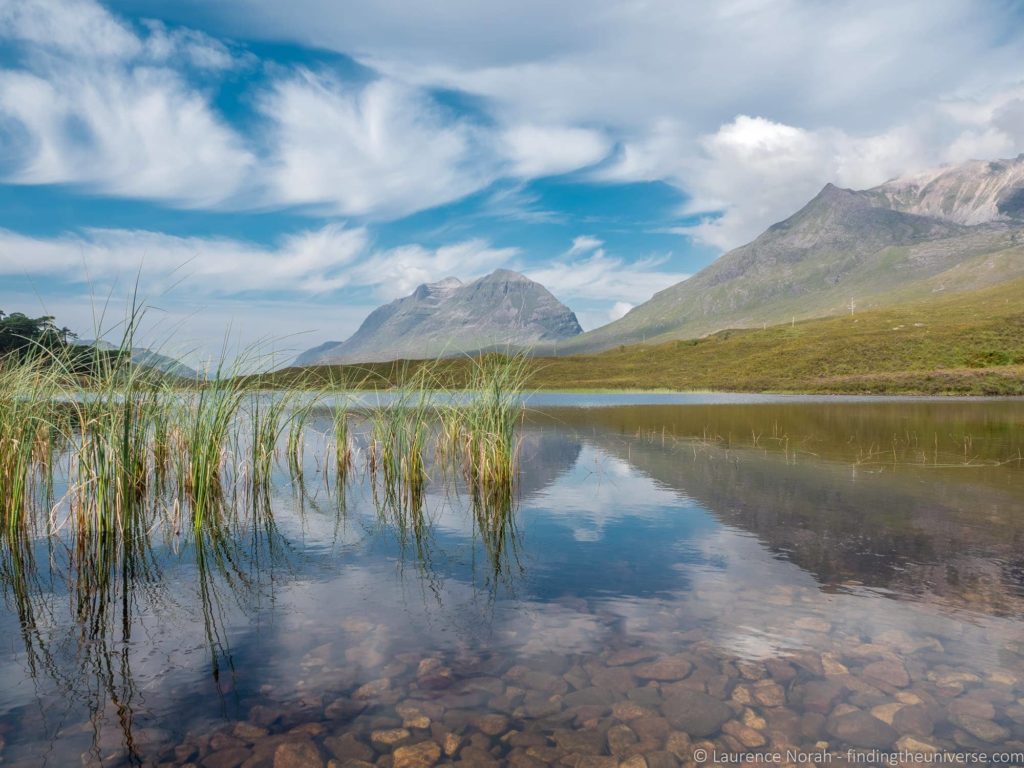
JPG is also a compressed file format. This means that diverse optimizations are applied to the epitome file, which makes the file size smaller. The greater the compression, the greater the loss in quality, but the smaller the file size and the less storage infinite needed to save it.
There are other types of pinch available, such as PNG files, HEIF files and and so on. They each have advantages and disadvantages. JPG is past far the almost widely used, with HEIF being the default on almost iPhones.
Compressed files are a good matter. They hateful that when nosotros load a webpage, we don't have to wait ages for all the images to load, and when we email images to friends, we don't take upwards too much of their inbox space.
There are downsides however to using a compressed file similar JPG or HEIF. A compressed prototype is a lot less flexible when it comes to editing, as much of the useful image data that image editors work with has been discarded in order to save file size. Additionally, the camera applies a number of tweaks to the paradigm when it saves information technology in a compressed format, including adjusting the saturation, contrast, and sharpness of the image. These changes are difficult to undo if you don't like them.
A RAW file on the other manus, is an uncompressed version of the prototype file. Essentially the camera takes the image data from the sensor, and saves information technology in an unedited and uncompressed format on the memory bill of fare.
This takes up a lot more space on your memory card. A RAW image file roughly works out to be around the same size as the number of megapixels of the camera – then for case, a 20 megapixel camera will save a RAW file of around 20 megabytes. Compare this to a JPG file of reasonable quality, from the same camera this will unremarkably be around 4 megabytes – five times smaller!
As I mentioned at the start of this section, every camera manufacturer has their ain RAW file format. For example, Catechism RAW files have the "CR2" file type. Nikon RAW files are "NEF" files. So instead of "Image.JPG", you would have "Image.CR2", or "Paradigm.NEF".
You tin can't simply grab these RAW file and upload them to the cyberspace or share them with friends. They likewise take upwardly more than space, and aren't of a universal file format. And so far, this doesn't sound great for RAW files!
However, RAW does have a number of advantages, which nosotros volition cover in this post. First though, a quick summary of the differences between RAW and JPG, which besides applied to RAW vs other compressed image types like PNG or HEIF.
RAW vs JPEG
Here's a quick overview of RAW vs JPEG:
- Both a type of photography image file
- JPG: small file sizes, approximately a quarter the size of a RAW file
- JPG: universal file format, RAW is unique to each camera
- JPG: can be shared anywhere without editing, RAW requires editing before it can be shared
- RAW: much greater control over the final image, JPG has reduced control equally much of the image data is discarded
- JPG: supported by vast bulk of smartphones and compact cameras. RAW support is simply on more expensive cameras similar DSLR's, mirrorless cameras, and some point and shoot cameras and smartphones
- JPG is an 8-fleck format, significant information technology can store information on up to 16 million shades of colour. RAW can store between 68 billion and four.three trillion colour shades, depending on the photographic camera, which is quite a lot!
Many of these comparisons are also true when comparing RAW against other compressed file formats like HEIF or PNG, although JPG is however the most widely supported compressed file format.
Why is RAW Capitalized?
Some other quick question – y'all might be wondering why the word "RAW" is normally written in majuscule letters. Well, unlike JPG, RAW doesn't actually stand for annihilation. Information technology'south besides not a specific file format, equally different photographic camera manufacturers employ their own file extensions, similar "CR2" or "NEF".
As far every bit I am able to ascertain, RAW is ordinarily capitalized for two reasons. Showtime, to distinguish it from the word "raw", which has its own definition. Second, as file extensions traditionally have always been capitalized (like .Md for Discussion documents, or .XLS for excel spreadsheets), this indicates that RAW refers to a filetype.
To exist honest though, there's no rule that says yous accept to write RAW rather than raw. It's up to you lot!
What are the Advantages of Shooting in RAW?
I'thou going to speedily get through some of the chief advantages of shooting in RAW, then y'all know why you should exist figuring out how to set your camera up to shoot in RAW.
1. You Keep all the Image Data
The major advantage you have when shooting in RAW is that you don't lose any valuable image data.
Why is this important y'all ask?
Well, permit's think of some examples. Sometimes when we shoot a scene, the sky might be besides bright, or the subject too dark. With a JPG file, it is very difficult to do much most that, as the prototype is essentially already in a final country and allow only for a small corporeality of editing.
With a RAW file, there's a massive amount of epitome information available, meaning you can recover skies that are too bright by reducing their effulgence, and increase the shadows and so they are brighter.
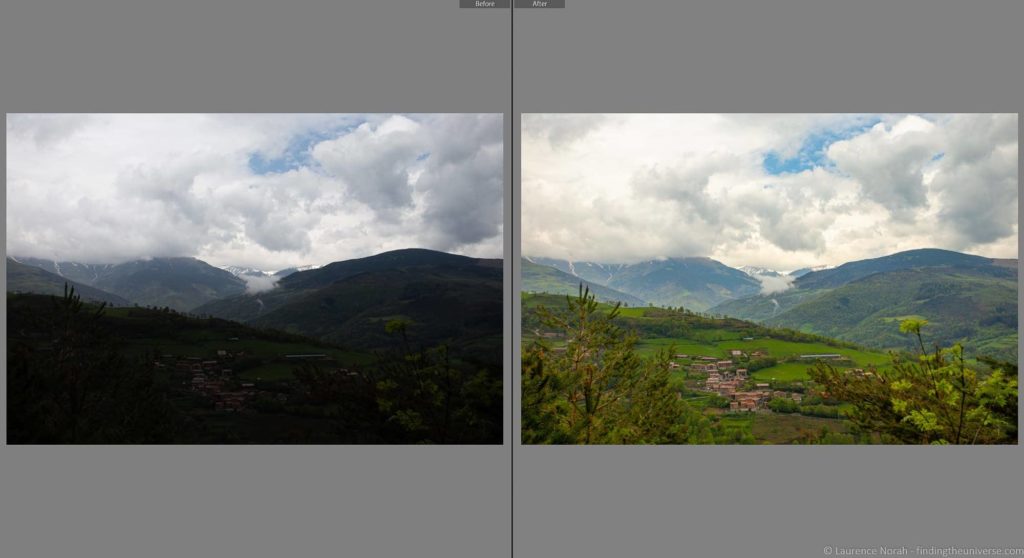
In the instance above, you tin can see the original RAW file on the left, and the edited version on the correct. As you can run across, I had to underexpose the hillside here, so every bit to accept the clouds and sky correctly exposed. And so, in mail, I was able to recover the shadow details and create a more counterbalanced and correctly exposed prototype.
In one case you've done this a few times on an image that y'all idea was almost useless, you'll wonder why you ever shot in JPG.
ii. White Residuum Adjustments
White balance is almost a whole other post, merely in cursory, when photographers talk about white rest, they are referring to the colour tone of the image. So for case, a warm white balance ways the epitome is a gilded yellow colour, and a cool white balance refers to a more blue looking image.
White rest varies depending on the source of the light. A tungsten bulb for instance will give a unlike tone of light compared to the midday sun, which volition look unlike to a setting dominicus.
Imagine if you concur upwardly a white piece of paper – you know the paper is white, but if you lot put the same slice of paper under all these different types of light, it would likely look a unlike shade or tone of white.
When you take a picture, the camera usually has to try and figure out the tone of the light, so your paradigm doesn't look too bluish or too yellow, and this is washed with the white balance setting.
When y'all shoot in JPG, the camera has to figure out this white balance and apply information technology to the image. When you shoot in RAW, you tin change the white balance afterwards the fact much more easily, meaning it is a peachy deal easier to adapt the tone of the image in post-processing, and "set" an epitome then it looks more natural and similar to reality.
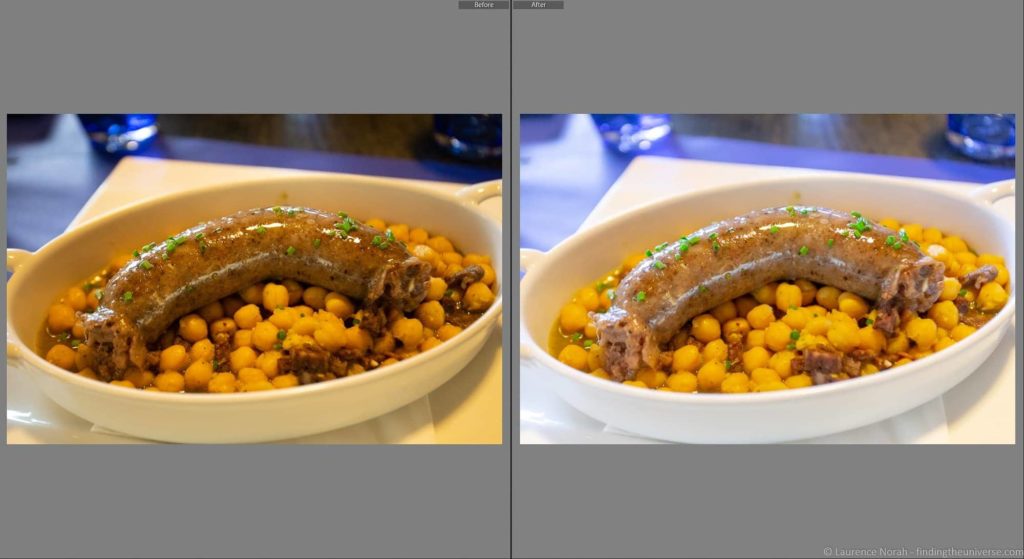
Equally an instance, you can encounter the original version of the image above, to the left, looks quite yellowish. This is because the light source is quite warm, and then the white bowl ends up looking a flake xanthous, as does the rest of the repast. By adjusting the white balance after the fact, we tin can brand the bowl look white, and the rest of the food looks more natural every bit a result.
three. Sharpness and Racket Adjustments
When y'all shoot in JPG, the camera applies a number of edits to the image data as office of the conversion process to give the final JPG image a particular look. This wait can normally be adjusted in the camera carte settings, and includes various things like colour saturation and dissimilarity, every bit well every bit noise reduction and sharpness.
Whilst the camera software is generally ok at these adjustments, you get a lot finer command over sharpness and noise reduction if y'all use a defended image editing tool similar Adobe Lightroom. And so especially for darker scenes, like indoor shots where you can't apply a flash or night photography, shooting in RAW and adjusting the dissonance and sharpness in mail processing will get you better results, resulting in a cleaner image overall.
When Should you not Shoot in RAW?
Whilst in that location are a number of obvious advantages to shooting in RAW, in that location are some reasons not to shoot in RAW.
Start, if you can't see yourself spending much time editing or working on your photos after pressing the shutter button on your camera, RAW might non be for you. Information technology will add fourth dimension to your workflow, and whilst the end result may be meliorate photos, if you just don't take the fourth dimension or inclination to do it, it's likely not going to be for yous.
Some other reason not to shoot in RAW is if y'all want to shoot continuous frames at a high burst charge per unit – say an action sequence. Because JPG files are a lot smaller, they tin can exist written to the camera's memory bill of fare a lot faster than RAW files, and the cameras internal buffer will also be able to store more photos, meaning you can shoot a outburst for longer.
So if capturing the moment is the most critical function of your shoot, RAW might not be for yous.
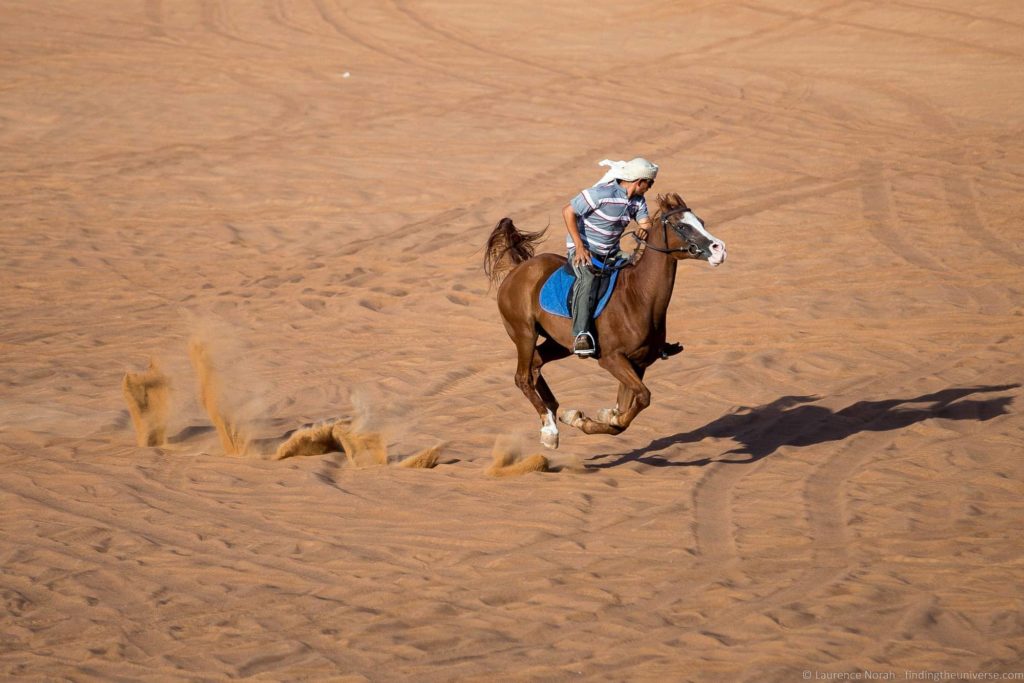
RAW is likewise not necessarily the best if the pictures are highly fourth dimension sensitive. When I've shot events for example, some printing photographers have been shooting JPG alongside me, because they demand to be able to rapidly deliver the photos to a customer so they can be published. In that location'due south only no time for the RAW editing process to take place.
Patently, this is a niche demand, but if having photos quickly is a priority, once again, RAW might non be right for your needs.
Sometimes of grade we also desire to be able to travel and share our images with friends and family unit, and we don't want to accept a laptop with united states on our trips. In these cases, RAW is too not ideal as you would ordinarily demand a computer to exist able to edit your photos. In these instances, nosotros'd propose shooting in JPG, and choosing a high quality setting to get the best results.
The exception is if you are shooting on your smartphone, as if it supports RAW shooting information technology will unremarkably have a built-in RAW editor that lets yous edit your photos and save them in a shareable format similar JPG.
Another option, rather than setting your photographic camera to only shoot in JPG, is to see if if lets you shoot in "RAW+ JPG". This ways the camera volition record both a compressed JPG version of the image, and an uncompressed version.
This is a good way to kickoff shooting in RAW without the overhead of having to worry about editing all your images. It will take up the most space on your camera retentivity card, and isn't suitable if you lot want to shoot fast bursts of images, such as for activeness shots, as writing so much data to your camera retention card for every shot will slow your camera down a bit. However, it is a practiced bridge solution before you lot go all in on RAW, which would be our recommended setting to aim for.
Why Do RAW Files Look Done Out?
One mutual question I'thousand asked is why RAW files look and then washed out compared to the JPG files. This is especially noticeable if you shoot both RAW and JPG, and load them up next to each other in your editing software.
The deviation will be quite obvious – the colours volition exist more than muted in the RAW file, and it might accept a more reduced contrast and non look equally sharp as the JPG file.
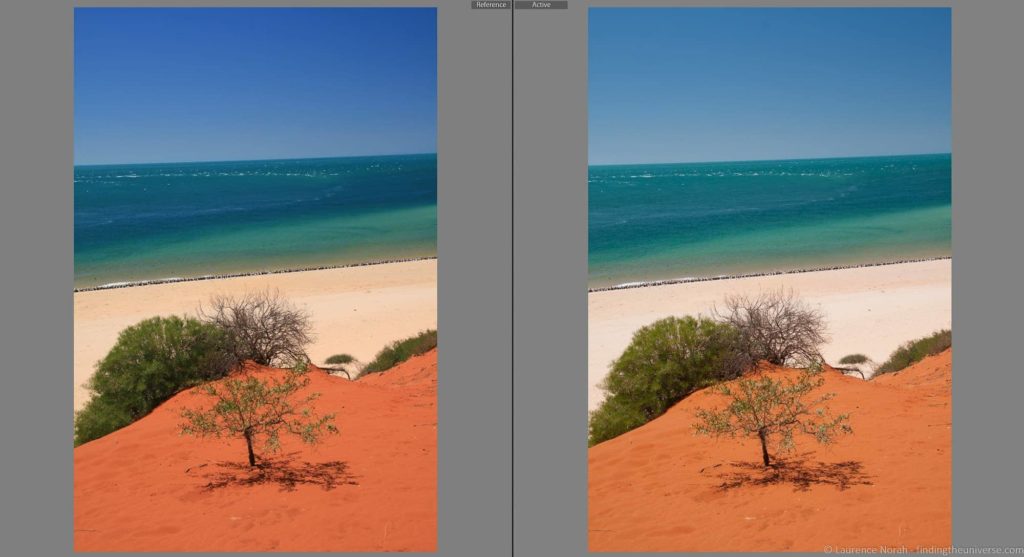
As an example, the left epitome above is the camera JPG, whereas the shot on the right is the RAW file. You tin see the the colours are a lot less vibrant in the unedited RAW file compared to the camera's JPG version of the exact aforementioned photo.
The reason for this is that when a camera processes the image data and saves it as a JPG, it applies what is known as an image contour to it. Essentially, the camera edits the photograph for you, putting it into a final, usable state. So this ways making it colourful, precipitous, and ready to publish.
A RAW file isn't edited at all. It'southward essentially a blank canvas – the data is ready for you lot to adjust into a final prototype, with the adjustments that y'all desire to make, rather than those that the camera wants to apply. And so whilst this ways that the initial image y'all look at won't be quite so impressive as the JPG version, the potential for creating something more impressive is at that place.
How To Enable RAW in Your Camera or Smartphone
The steps you lot need to take to enabling RAW back up will vary across manufacturers, but will usually involve you accessing an epitome quality setting in the carte system. This should be a fairly easy setting to admission and modify.
On Catechism cameras for example, yous access the Bill of fare by pressing the "Carte" button, and then accessing the image quality setting from ane of the outset screens (this will vary past camera model).
When you lot find the "Image Quality" option, press the "Fix" push to access it. You can then choose the RAW quality level (we suggest the highest quality option, if in that location are options). You can as well arrange the JPG quality option here.
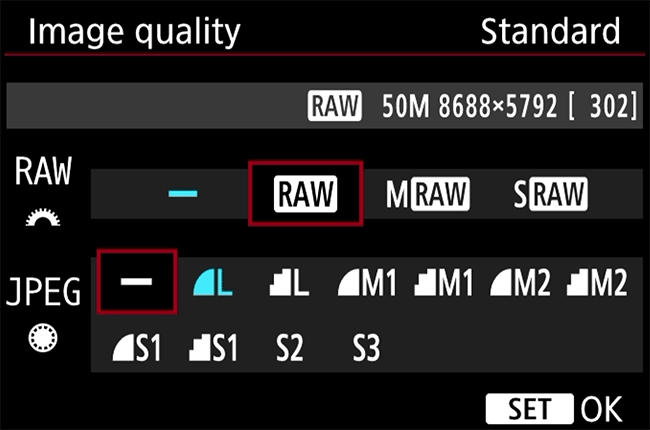
For specific instructions for your Canon camera, have a look at the Canon Support website, which will have stride by step instructions. For example, these are the instructions for my Canon 6D photographic camera.
You lot can find the support site for Nikon here, for Sony here and for Panasonic here. For other manufacturers, simply searching for "Manufacturer name camera back up folio" should get you the documents you need.
On Smartphones, similar the iPhone or Samsung Galaxy, if RAW support is available it will normally be a toggle inside the camera app.
How to Open a RAW file?
To open a RAW file, you demand viewing software that specifically supports the RAW file produced by your photographic camera.
As mentioned higher up, RAW files are not universally recognized file types, and they vary from manufacturer to manufacturer. To get the most out of your RAW file, you'll need to edit it, and then convert information technology to something like a JPEG so yous can distribute it.
Usually your photographic camera or smartphone will come up with a RAW file viewer and editor, and many pop image file viewers also support various RAW files, although back up varies based on your camera manufacturer and model.
If you don't have a RAW file viewer, we can suggest Microsoft Photos, Fast RAW viewer, or one of the editors listed below, as a starting point. On smartphones, the congenital in photo viewer and editor should back up your smartphones RAW file format if your smartphone supports RAW.
Which RAW Photo Editor is Best?
At that place are a number of options when it comes to editing your RAW files. These include:
- Adobe Photoshop Lightroom Classic CC (monthly/annual subscription, Mac & PC)
- On1 Photo RAW (monthly/annual subscription, Mac & PC)
- Capture 1 (standalone license or monthly subscription available, Mac & PC)
- Luminar (standalone license, Mac & PC)
- Darktable (gratis, Mac & PC)
- RAWtherapee (gratuitous, Mac & PC)
- RAW editing software that comes with your camera (costless)
My preferred tool for editing my RAW files is Adobe Lightroom. This is because it offers a full photography workflow, significant I tin can manage all my photos as well every bit edit the RAW files. I also find the interface and RAW editing to be the best suited to the mode I piece of work. It is also the product, I believe, with the about guides online, meaning information technology'southward easy to acquire how to apply it.
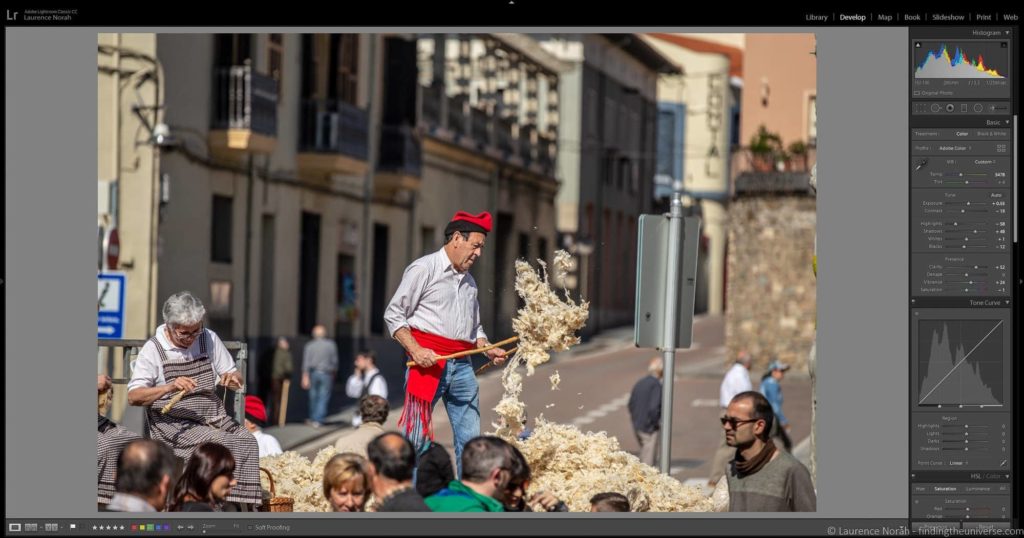
Of course, I appreciate that the monthly subscription can be an issue for many, and unfortunately Adobe have discontinued the one-off license fee option. The advantage of this subscription model is that you lot are e'er kept up to engagement with the latest product releases, and I actually call back that the lifetime cost of this model is no different to buying a single product and then paying for yearly updates. You can too try it every bit a trial version, and you tin can cancel afterwards your subscription expires if y'all don't want information technology whatever more.
Withal, if yous don't desire to commit to a monthly (or almanac) subscription, at that place are other photograph editing options that I embrace here.
The best ii alternatives that I propose you check out are On1 Photo RAW and Skylum Luminar. Photo RAW is the closest replacement to Lightroom I have plant, with a similar interface and a 1-off payment option.
Luminar offers a more than automatic workflow with congenital in AI tools to make editing more accessible. It also offers full RAW editing support, and is designed to be easy to utilise.
Both tools are available for a i-off purchase price. I recommend trying them both and seeing which you prefer. You lot can download a Luminar hither to try information technology out (there's a xxx mean solar day money dorsum guarantee), and Photograph RAW hither with a 30 day trial.
Nosotros also accept an exclusive Luminar discount code for readers who decide to purchase Luminar, which will get y'all $ten / €10 off the price of Luminar. The code is TRAVELCATS , but enter it at checkout for the discount.
There are as well a number of free, open-source image editing solutions. These can be an easy way to dip your toe into RAW file editing without whatever cost. The features they offer vary, and there are less tutorials bachelor online, so they can be a chip more overwhelming when you lot are starting out.
If your camera supports shooting in RAW, it should come up with software to enable you to edit the RAW files. For example, Canon cameras come with software chosen "Digital Photo Professional", which offers full RAW file editing back up for Catechism RAW files. Nikon cameras ofttimes come with complimentary Capture NX-D software to edit Nikon's .NEF RAW files. This software is some other skilful option for costless RAW file editing, although won't allow you manage your photos or organise them.
For tips on choosing software to edit your RAW files, see our full guide to the best photo editing software. If y'all're looking for something to edit your photos on, see our guide to the all-time laptops for photo editing
Further Reading
Hopefully this post has helped yous get an understanding of what RAW is in photography, also as give you an overview of why yous might want to shoot in RAW.
Every bit well as this postal service, nosotros have a number of other detailed photography posts to help you get the best photos. Here are some we think y'all volition notice useful.
- Our run downwards of the best photo editing software, so you have a tool to edit your RAW files. We as well take a guide to the all-time laptops for photograph editing
- Our guide to the exposure triangle, a fundamental photography concept
- Our guide to picking the all-time travel camera, which features a range of cameras at various toll points. We also have a defended guide to picking a compact photographic camera for travel and best action camera, some of which feature RAW back up, and a guide to the best DSLR camera for photography, all of which feature RAW support.
- If yous demand a new lens, we have a guide to the best travel photographic camera lenses which covers the majority of camera types available today
- If you want to purchase a lensman you know a gift, and want some ideas, check out our detailed gift guide for photographers
- We have a guide to taking better pictures of yourself, how and why to apply back push button focus, how to have pictures of stars, how to photograph the northern lights, and an overview of Neutral Density filters – just some of our photography posts!
- We also have an e'er expanding series of Photography Location Guides, to help y'all get the best shot in locations around the world.
- A Beginners' Guide to Improving your Travel Photos for those starting out in travel photography
- Our reasons why you need a travel tripod
Looking to Meliorate Your Photography?
If you found this post helpful, and you desire to improve your photography overall, you might want to cheque out my online travel photography course.
Since launching the course in 2016, I've already helped over 2,000+ students acquire how to take better photos. The course covers pretty much everything you need to know, from the basics of how a camera works, through to composition, light, and photo editing.
It likewise covers more advanced topics, including astrophotography, long exposure photography, flash photography and HDR photography.
Y'all become feedback from me equally you progress, access to webinars, interviews and videos, also equally exclusive membership of a facebook grouping where you tin become feedback on your work and take part in regular challenges.
It's bachelor for an amazing one-off toll for lifetime admission, and I recall you should check it out. Which you can do by clicking here.
And that'south it for our guide to shooting in RAW. Hopefully this has inspired you lot to find the RAW setting in your camera and start using information technology. As e'er, if you accept any questions or feedback virtually this postal service, or any travel and photography questions, just let us know in the comments beneath!
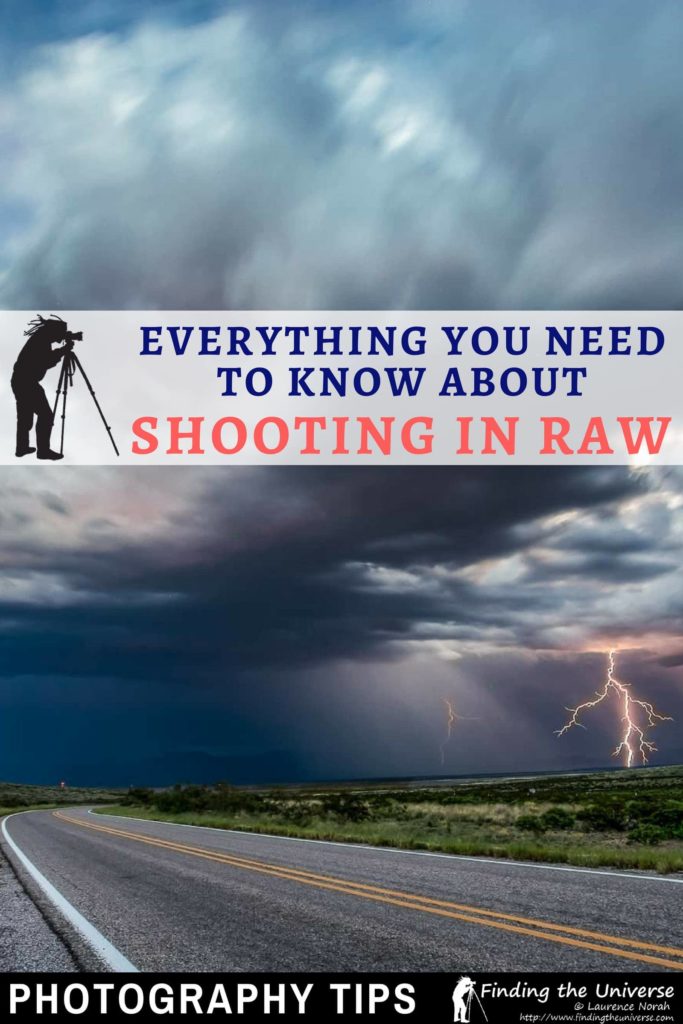
Source: https://www.findingtheuniverse.com/what-is-raw-in-photography/
0 Response to "Why Is Camera Upload to Pc So Slow?"
Enregistrer un commentaire